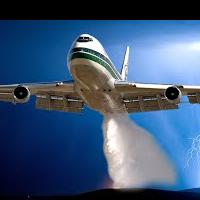The History of Weather Modification
This is the history of human weather modification.
During WWII, too many British Air Force pilots were crashing while trying to land in heavy fog so thick some crews just ditched their planes in the sea and parachuted out, rather than landing blind.
So scientists came up with a plan to install gasoline pipelines along both sides of the runway and ignite them to create huge rows of flame, which then evaporated suspended fog droplets, allowing the Allied aircraft to locate the airfield and land safely. In 1946, techniques were developed that triggered rain and snowfall in places that wouldn't have gotten any otherwise.
This became known as cloud seeding. It works by dispersing dry ice, salt, or silver iodide into clouds to alter their microphysical processes. In the early 60’s the US Government began testing cloud seeding on hurricanes to learn if it was possible to weaken them.
Rocket canisters of silver iodide were dropped from aircraft into the storm's eye, and gun-like devices mounted on the wings also sprayed the stuff onto the clouds. Initially, the tests seemed to work. Wind speeds were cut and, in some cases, the hurricane eyewalls even fell apart. But as observational technology improved and more controls were carried out, the hypothesis was invalidated and the program was cancelled. In its desperation to win the Vietnam War, the Americans turned to weather modification to make it harder for the enemy to move throughout the region by inducing heavy rainfall to muddy or destroy their dirt roads and trails.
47,000 canisters of silver iodide were dropped over North and South Vietnam, Cambodia, and Laos. Some areas supposedly saw their monsoon period extended by up to 45 days. Two days after the New York Times exposed the program, it was discontinued. This caused the USSR and US to negotiate a ban on the military use of offensive environmental modification techniques in 1977.
But the treaty didn't stop countries from using cloud seeding against themselves, as the Soviet Union did in 1986 when the Chernobyl nuclear disaster sent fallout into the sky. Civilians on the ground and the Russian pilots who carried out the mission have confirmed that aircraft flew overhead ejecting a substance into the clouds. This resulted in heavy, black-colored, radioactive rain to fall in Belarus, instead of onto the Soviet capital, Moscow. Today, 37 countries are operating weather modification programs to enhance rainfall or suppress hail.
But nobody does it quite like the Chinese, who established the bureau of weather modification in the 1980’s, that's now a 37,000-people sort of weather national guard, ready at a moment's notice to operate the more than 4,000 rocket launchers, 7,000 antiaircraft guns, and 30 aircraft to trigger downpours in drier areas that really need the rain. The bureau's highest profile operation was keeping Beijing's Birdsnest stadium dry during the opening ceremony of the 2008 Olympics. The following year, the bureau dropped 186 doses of silver iodide into a cold front to bring drought-stricken Beijing its earliest snowfall since 1987. A Swiss company took advantage of the United Arab Emirates' desperation to bring rain to its arid lands, by building 10 meter-tall electrical towers that produce negatively-charged ions that, according to the company, supercharges the formation of rain clouds.
But, a former chairman at NOAA isn't buying it, saying, “this method is inherently incapable of producing clouds out of thin air.” The thing about weather modification is that it's hard to prove it works, but based on the results we've seen -- and the number of countries still doing it -- man's effort to control precipitation isn't stopping anytime soon, even though we have little understanding of the unintended consequences. If this video opened your eyes to the reality of weather modification as much as it did mine, like it and help it spread.
And, as usual, thanks for watching.

